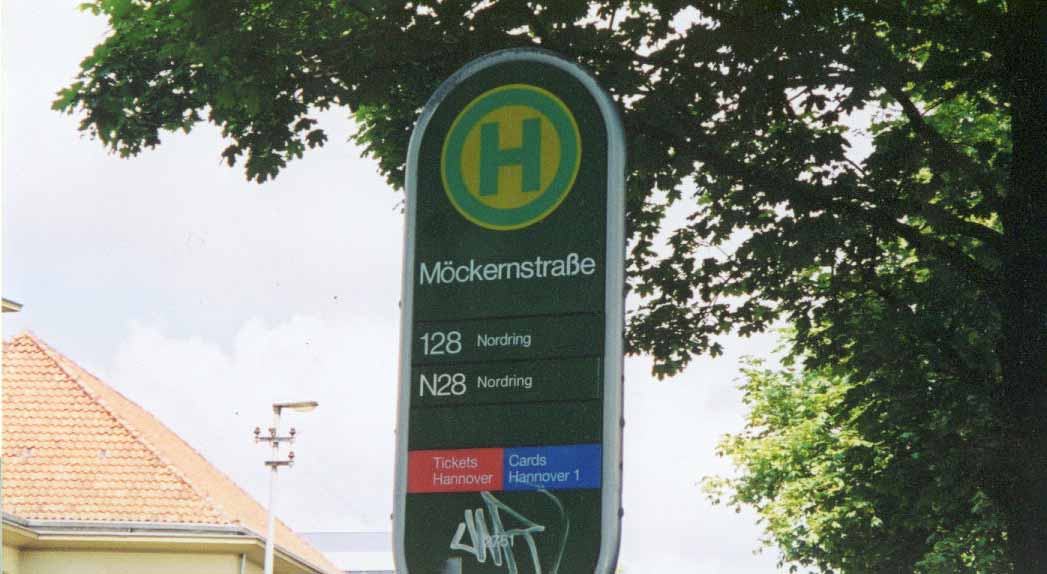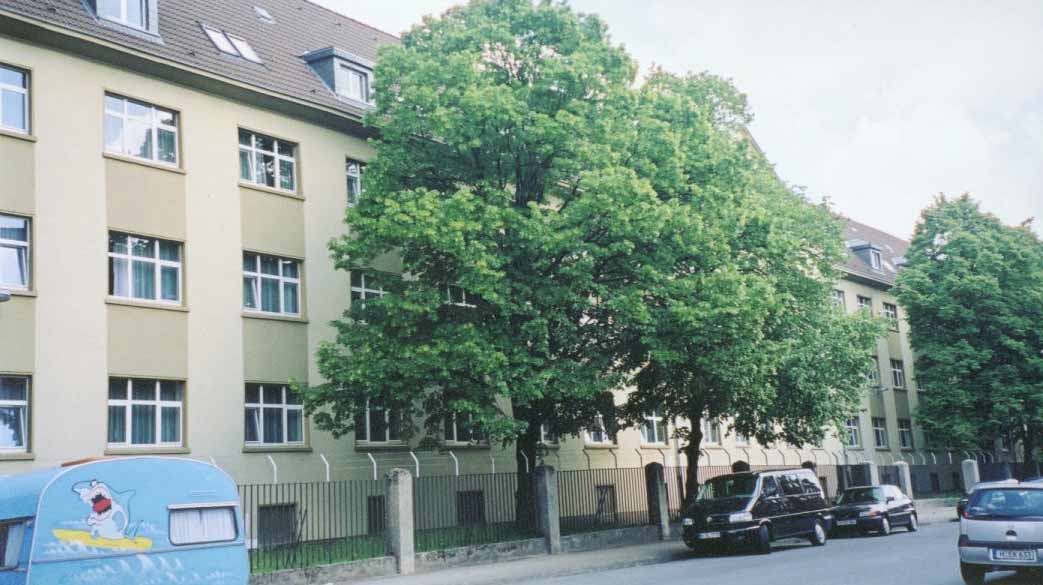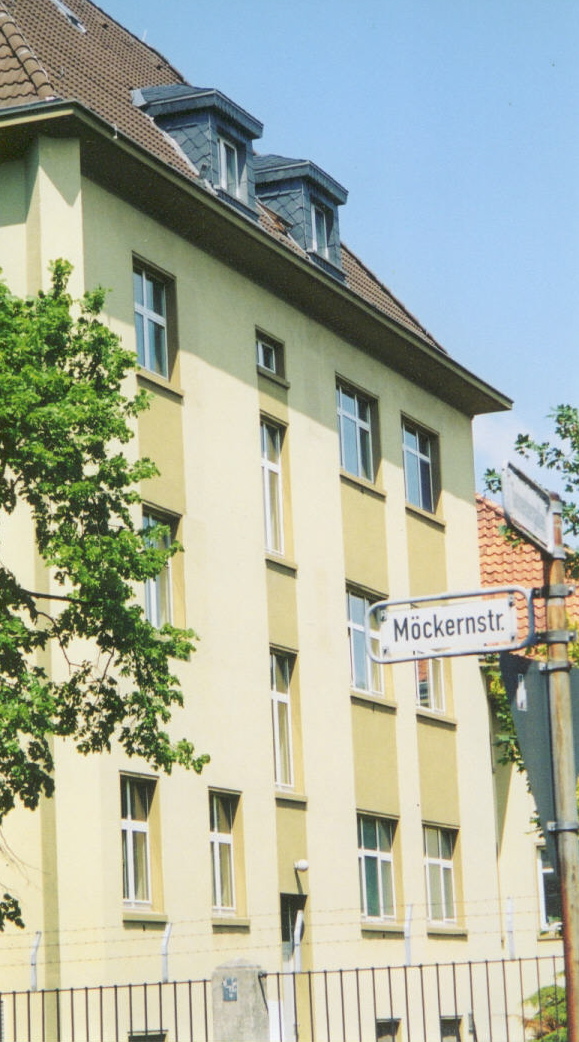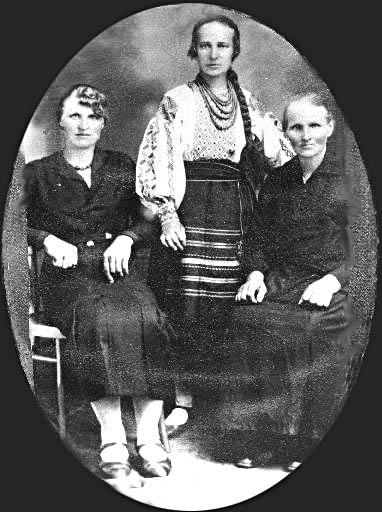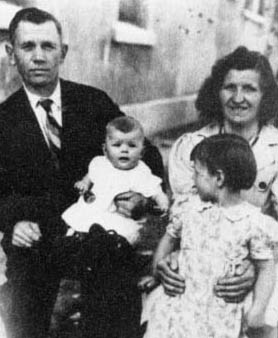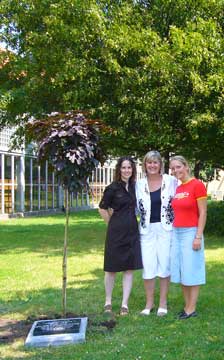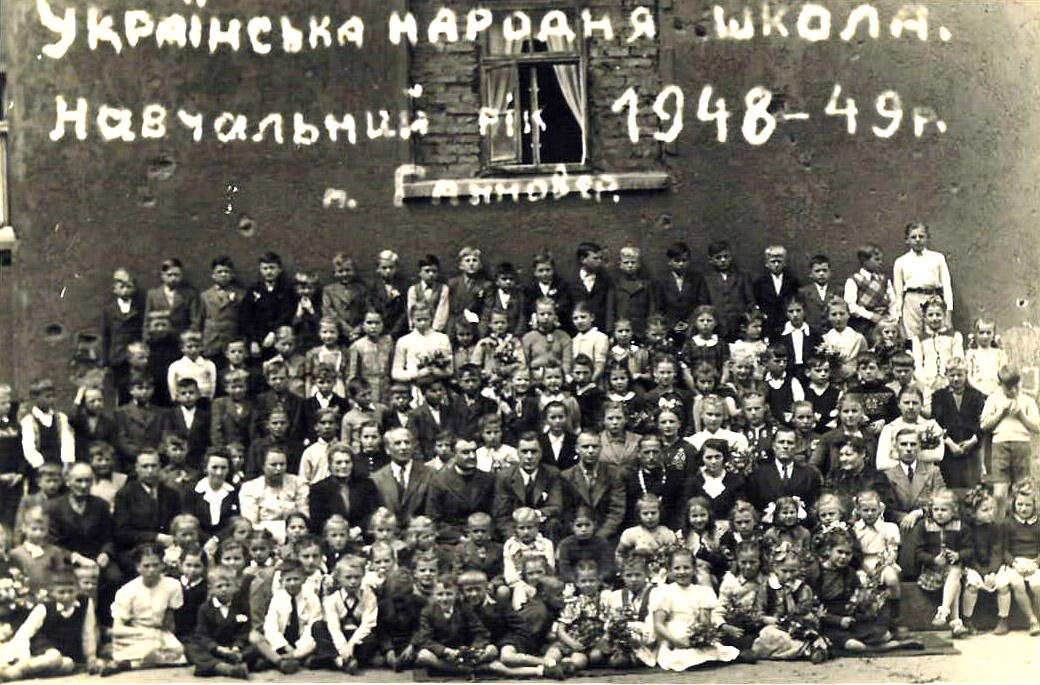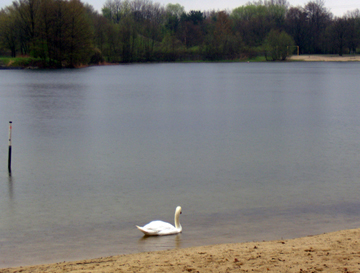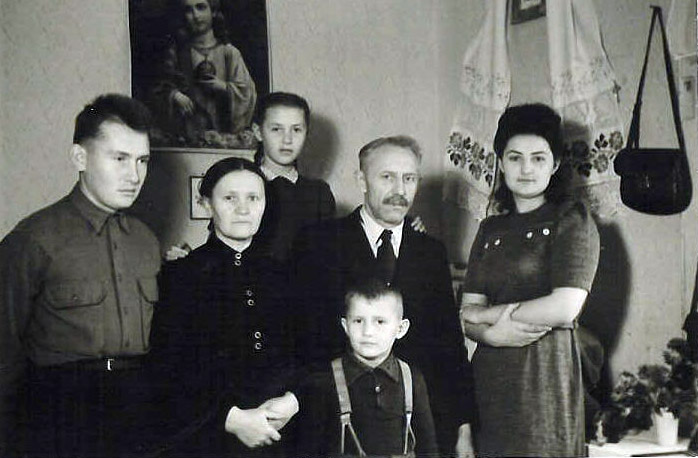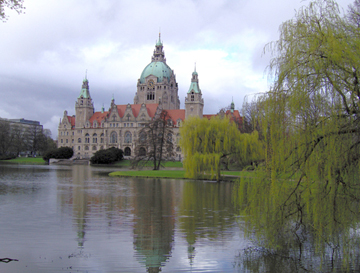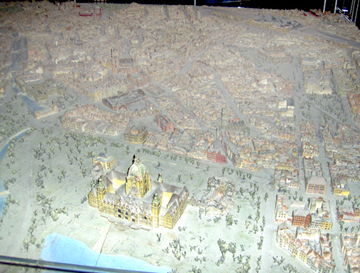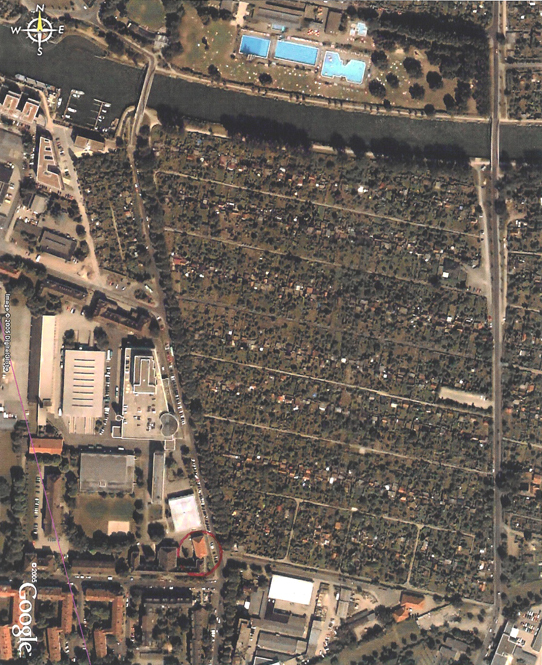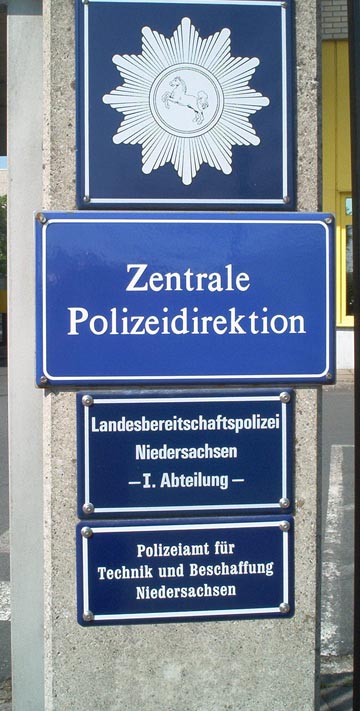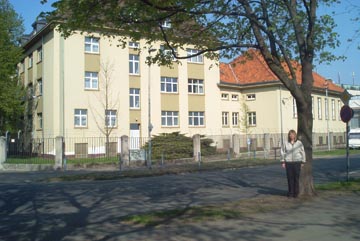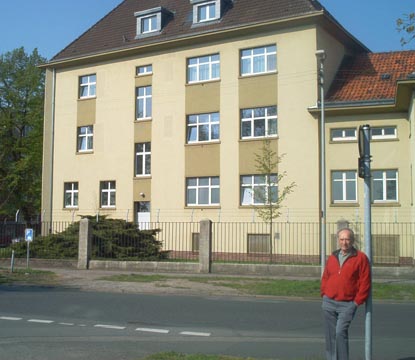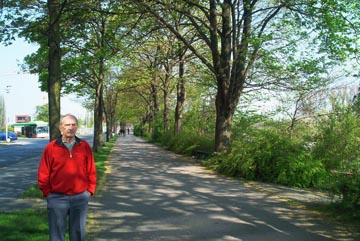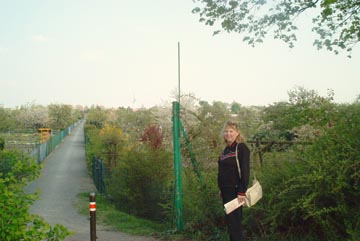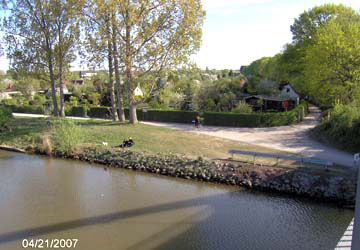Alexandra
Tesluk Gibson shares some of her research with us:
This
camp was named Lyssenko camp and
was situated in Moeckernstrasse 21 - 27. It had the DPAC
number 2715 from December 1946 to June 1947, and the DPACS
number 14/76/96/2715 from May 1947 to March 1948. From April 1948 to June 1949 the camp
had the number 76/2716; at that time mostly Polish Ukrainians lived
in this camp.
Fallingbostel, Marx and Oldenburg were three different camps located
in three different regions. Wolfgang
Strobel, author of Post der befreiten Zwangsarbeiter - Displaced
Persons Mail Paid in Deutschland 1945 - 194
Mockernstrasse Today:
This is a bus route. Also, I'm pretty sure that the building still houses some kind of military installation. If you look closely, there is barbed wire fencing in front of the building and it not only enclosed the building but it extended around almost an entire city block, plus you could only enter through a gate with a guard in attendance - this was my major clue that it was where maybe your parents were living as we never could find an actual number on any of the buildings. Mockernstrasse is really a short street. Sophie
Note from Jan:
Just looking at those pictures and without having been there I can at least
comment that this is definitely some kind of an official governmental building.
It is pretty well maintained, even the security measures are pretty much
up to date. I would guess some city or provincial administration will be
housed there. The outer looks resemble a typical barracks building from
the late 20s or early 30s, probably updated in the 60s and then maintained
until today. A restricted access indicates this building is still used
by some security detail, e.g mobile police or civil defense. I could very
well imagine this building was used after the war to accomodate refugees.
(So was our house in which we are living since 1988. It used to be the
former school house of this community and was confiscated by the British
in May 1945 as a shelter for DPs.) Warm regards, Jan
July 6, 2003
City of Hannover
Department of Public Libraries and Schools
City Archives
Dr. Mechler
Am Bokemahle 14 - 16
30171 Hannover
Dear Mrs. Tesluk,
We have tried intensively to gather information about DP camp 36/4
Möckernstrasse in the records of the City of Hannover. To
tell you frankly our research has proven only very little results.
In our records we could find only a Einwohnermeldekarte (registration form for residents of a community) made out in your name, carrying your birth date, the number of the entry into the births records of the registry office, your religion, the names of your parents, and the place of residence. A copy of this registration form we have included in this letter.
According to this registration form you were born in the Provincial Womens Hospital at 5 Herrenhäuser Kirchweg and were living at Camp Möckernstrasse. Unfortunately there are no further details given about this camp, e.g. "camp 36/4". The area of Möckernstrasse is known to us as a housing area for military staff during the war, these people were living in barracks. After the war the area was turned into living quarters for former forced laborers staying here until their repatriation. The building Möckernstrasse 27 was called Lyssenko Camp, which is named differently in another source: "76 D.P.A.C.S.".
We have in our possession a list of all people having lived in this camp between October 1945 and June 1950. Unfortunately neither your parents nor you are listed. One possible explanation might be your family has been accidentally forgotten to enter into this list, another reason might be there have been more camps than just Lyssenko at Möckernstrasse - but in our records we are lacking information about such camps.
All DP camps were under control of the British Military Government, the German administration took over only in June 1950. At this point of time (June 1950) there was only one DP camp at Möckernstrasse 21 - 27: Lyssenko Camp. In early June 1950 there were more than 3.100 men, women, and children living in this camp, most of them were from the Ukraine and White Russia (hope this is correct: Bielo Russia, can't find the English name in my dictionary).
For further research, we recommend the Archives of the State of Lower
Saxony .... or the Public Record Service ...Great Britain. Both have
records about the administration of these DP camps.
We are very sorry we can't give you more detailed answers.
Kind
regards, Dr. Mechler
Letter from J. Kuhl:
It might be wortwhile to write to the British Public Records Office, this I
would guess might be the best bet as the British were the ones to have
all DP camps within their occupational zone under control - if anybody
at all they should have records.
... This was combined with the general tracking service in 1991 when in the course of the German reunification the sister organisation of the German Democratic Republic was taken over by the German Red Cross and both tracking services were united in Munich. So both organisations are actually integrated into one service and their combined knowledge has helped to clarify the fate of a few hundred thousands of missing people or has assisted in the reunification of families having been separated for decades. But much to my surprise I learned there are more ten 2 million cases still open - including those of people who have disappeared from East Germany and their whereabouts remain unknown until today.
This guy told me that a search like the one you are trying is virtually impossible on a private basis. Too many files of DP camps have been lost or were actually never set up or maintained. Some files of persons living in those camps have been passed on later by various military governments or administrations to the German administration but it took the Red Cross until the early 70s to get those registers together - with most likely several data lost again as these files were set up by various bodies (communities, allied military, even private organisations and churches had their own files). You can imagine what kind of different data had to be put together to allow the Red Cross tracking service to find more than 30 million missing people.
To take a long story short: as there is basically no other organisation which has access to those files and archives your best bet is still the German Red Cross - especially as community offices are not known to be very cooperative especially if they have to deal with requests of foreigners. For German nationals they are a pain in most instances.
Don't give up hope, if you have already registered with the tracking
service your request will be answered some day - hopefully to your
liking. Good luck with your research!
J. Kuhl, Germany
Photos below left to right: Left to right: 1) my mother Olga (Helka), her sister Stella and my grandmother, Telka TESLUK, in the 1930's / 1920's.
2) My mother in early 1946 was expecting me in this photograph. I am still trying to find my father, Andreas Tesluk, who didn't travel with us to Canada. Andreas' missing fingers are quite prominent here.
Photo taken in Lager Mockernstrasse in approx.1947.
3) Left to right: Andreas TESLUK, Alexandra (me) sitting on his knee, my mother Olga (Helka) and sister Maria. Andreas' left hand has missing fingers. He may have been tortured.
Alexandra Tesluk Gibson's photos:
I was born in a camp in Hannover: the 36/4 is listed on my baptismal certificate; Lager
Moekenen is listed on my birth certificate. Do you have any information
on Camp Moeckernstrasse in Hannover, the still missing Andreas Tesluk or other Tesluk family
members?
The name of the church: St. Joseph Church on Isernhagener Strasse. I had crosschecked and found this church has been used after the war by the Ukrainian Greek-Catholic Church for their functions. The name of the church isn´t specified on my baptismal certificate, just the name of the priest and the area. Alexandra Tesluk Gibson
Below left: Here I am again in Camp Lyssenko. I planted a maple tree and set a plaque in memory of my father who disappeared in 1948. On my left is my niece, Katherine Stewart and my friend Hendrike Kuehl (far right). (August, 2007)
George [email protected] December
02, 2005, I have included a few photos: Here is the Ukrainian school in
Lyssenko.
I am on the 3rd row, far left, behind the older gent. Is your
sister there?
Above, middle:
Silbersea lake in Hannover.
Many Lysenko people used to go there for swims. Above right: Hannover's gorgeous City Hall Model of Hannover at end of war.
They did not rebuild the church and
use it as reminder of that time.
Lysenko was in the upper right hand direction but off the model about ten blocks away. I am attaching an air photo showing the S.E. corner of Lysenko. The red circle near the bottom is were I lived in the block with the orange roof. I think your block would have been one of the darker roofs to the left.
To the right are the orchards and to the top is the canal and swimming
pools were my dad took me for long walks.The church in the model was
bombed and would not be the one you were baptized in. About three blocks
south of my red circle is a church we went for Christmas in about 1946-1947
and may be the one. Unfortunately the air photo does not go that far
and I don't know its name. I also found some Ukrainian churches on
the internet:
Ukrainian Greek Catholic Churches:
Ukrainisch-griechisch-Katholische Kirchegemeinde St. Wolodymyr (St. Vladymir)
Ukrainisch Ökumenisches Zentrum Wolodymyr
Hannoversche Strasse 122, 30627 Hannover
Below: My family (mom, dad, three sisters, two bothers) was one of the first to move into the camp. My sister, Halyna, was a teacher in the school which began in 1946 (I think). Our apartment was in the very south-east corner of the camp. Across the road to the east, by the orchards was a small store where I recall buying candy and pop. The store is still there, but is now a day-care centre.
To the right is the apartment we lived in for 5 years. The annex to the right was originally a gymnasium, but in 1947 (I think), it became the Ukrainian church and my Dad was a deacon there. His name was Mykola Xomenko. The lady in front is my wife, Judy.
Above middle: This is the same apartment looking south with the church
annex on the right.
Above right: This is a close up and our window is on the second floor left on me.
I still can’t believe how everything is just as I remembered and all the
buildings have been so well maintained. I think they are in better shape now
than when I left 55 years ago.
Hope this
is a little more clear to you. Le me know if you need more.
George [email protected]
For layout of the camp, download LyssenkoBaumpflanzplätze.pdf
The Ashes of Innocence, by Alexandra Tesluk, is a powerful, gripping page-turner. Blending intense psychological trauma, interspersed elements of beauty and love, Tesluk guides you on a journey, recollecting a childhood filled with repetitive physical, mental and emotional abuse and her search for her father lost in the rubble of World War II.
"The English kids laughed at me. The only way that I knew how to identify myself was by the DP label, which everyone else gave me. And, no one wanted to sit beside a DP. I didn't know what it meant, but I could tell by their laughter and pointing fingers that it wasn't a good thing to be. School created more trouble for me at home, too. If I was delayed and came home late, or had a bad report card, I would be punished."
Order from http://www.volumesdirect.com
